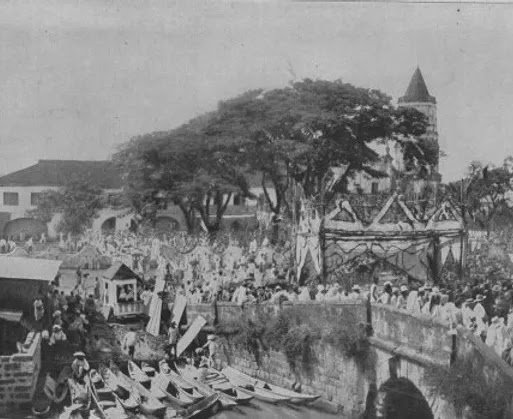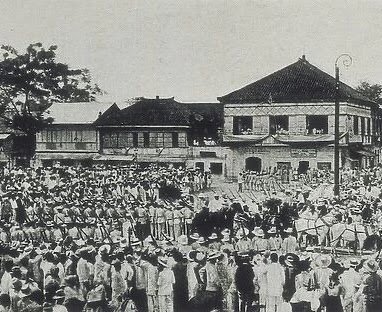MALOLOS CONGRESS



The history of Barasoain Church is deeply intertwined with the history of the Philippines itself. When General Emilio Aguinaldo moved the capital of the Revolutionary Government to Malolos, a significant national convention was convened on 15 September 1898, within the walls of Barasoain Church. The purpose of this convention was to draft the country's Constitution. Witnesses of this historic event recall a grand opening day, with the houses along the procession route, now known as Paseo del Congreso, adorned with vibrant decorations made of palmera leaves and flags. A total of one hundred and ninety-three delegates, representing each province of the Philippines, including notable figures like Fr. Gregorio Aglipay, Felipe Calderon, Antonio Luna, and Teodoro Sandiko, were in attendance. Pedro Paterno was elected as the president of the convention. It was on 29 September 1898, within the confines of this church, that the independence of the Philippines was officially ratified—a declaration that had previously been announced in Kawit, Cavite, on 12 June 1898.
Following heated debates, on 21 January 1899, the constitution was formally ratified. The republic was inaugurated two days later, on 23 January 1899, with General Emilio Aguinaldo taking the oath as its first president. Although the First Philippine Republic endured for only two years, it echoed the fervent desire of the Filipino people for independence, self-governance, and the right to wave their own flag. Barasoain Church, originally constructed as a place of worship, also played a pivotal role in declaring the nation's independence. This significance has earned it the title of the "Cradle of Freedom" and the "Shrine of Democracy."
In addition to its historical importance, the convent of Barasoain was designated as the site for the Universidad Literaria y Cientifica de Filipinas through a law passed on 19 October 1898. Don Mariano Crisostomo served as the secretary for this institution, which also housed the Instituto Burgos. Unfortunately, the university was dissolved when American forces entered Malolos.
On 1 August 1973, by virtue of Presidential Decree No. 260, Barasoain Church was officially declared a National Shrine. This decree provided for the preservation and enhancement of the shrine due to its remarkable and integral role in the history of the country. Today, and in the future, visitors can expect a well-maintained and immaculate place that stands as a silent witness to the period when Filipinos passionately aspired to create an independent nation.
SESSIONS HELD
Regular session: 15 September 1898 – 13 November 1899
Special session: 4 February 1899
LEADERSHIP
President: Pedro Paterno
Vice President / Deputy: Benito Legarda
Secretaries: Gregorio S. Araneta and Pablo Ocampo
MEMBERS
ABRA
Isidro Paredes
Juan Villamor
ALBAY
Honorato Agrava
Marcial Calleja
Salvador del Rosario
Pantaleon Garcia
Aguedo Velarde
ANTIQUE
Ariston Gella
Vicente Lopez
Eusebio Natividad
BATAAN
Hermogenes Marco
Pedro Teopaco
Jose Tuazon
BATANES
Vito Belarmino
Daniel Tirona
BATANGAS
Gregorio Aguilera
Ambrosio Flores
Eduardo Gutierrez David
Mariano Lopez Elected
BOHOL
Tranquilino Arroyo
Labio
Pedro Tongio Liongson
BULACAN
Trinidad Icasiano
Pedro Serrano Laktaw
Mariano Crisostomo Lugo
Ambrosio Rianzares Bautista
CAGAYAN
Anastacio Francisco
Vicente Guzman Pagulayan
Pablo Tecson
CAVITE
Jose Basa
Severino de las Alas
Hugo Ilagan
Jose Salamanca
CALAMIANES (CALAMIAN, PALAWAN)
Norberto Cruz Herrera
Narciso Hidalgo Resureccion
S. Isidro
CAMARINES
Tomás Arejola
Justo Lukban
Mariano
Valeriano Velarde
CAPIZ
Mariano Bacani
Juan Baltazar
Miguel Zaragoza
CATANDUANES
José Alejandrino
Marcelino de Santos
CEBU
Ariston Bautista
Felix David
Francisco Makabulos
Trinidad Pardo de Tavera
ILOCOS NORTE
Gregorio Aglipay
Primitivo Donato
Martín García
José Luna
Pedro Paterno
Pio Romero
ILOCOS SUR
Marcelino Crisólogo
Mariano Fos
Francisco Tongson
Ignacio Villamor
ILOILO
Venancio Concepcion
Esteban de la Rama
Melecio Figueroa
Tiburcio Hilario
ISABELA
Raymundo Alindada
Eustacio del Rosario
Abelardo Guzman
LA UNION
Mateo del Rosario
Joaquin Luna
Miguel Paterno
LAGUNA
Higinio Benitez
Graciano Cordero
Mauricio Ilagan
Manuel Sityar
LEPANTO (CERVANTES, ILOCOS SUR)
Leon Apacible
Reymundo Jeciel
Antonio Rebello
LEYTE
Simplicio del Rosario
Rafael Guerrero
Lucio Navarro
Marciano Zamora-Concepcion
MANILA
Arsenio Cruz Herrera
Felix Ferrer Pascual
Teodoro Gonzalez Leano
Mariano Limjap
MASBATE
Alberto Barretto
Maximo Cabigting
MINDORO
Antonio Constantino
Arturo Dancel
Perfecto Gabriel
MISAMIS
Gracio Gonzaga
Apolonio Mercado
Teodoro Sandiko
MORONG (RIZAL)
Marcelo Mesina
Jose Oliveros
NEGROS OCCIDENTAL
Juan Benson
Jose de la Vina
Antonio Montenegro
NEGROS ORIENTAL
Pío del Pilar
Mariano Leogardo Oirola
Luciano San Miguel
NUEVA ECIJA
Epifanio de los Santos
Gregorio Macapinlac
José Turiano Santiago
NUEVA VIZCAYA
Hipolito Magsalin
Evaristo Panganiban
PADRE BURGOS (BENGUET)
Joaquin Baltazar
Ceferino de Leon
Sixto Zandueta
PALAOS (PALAU)
Isidro Tiongco
PAMPANGA
Joaquín González
Ramon Henson
Enrique Macapinlac
Jose Rodriguez Infante
PANGASINAN
Sebastian de Castro
Vicente del Prado
Antonio Feliciano
Adriano Garces
PARAGUA (PALAWAN)
Felipe Calderón
Domingo Colmenar
SAMAR
Servillano Aquino
Javier Gonzalez Salvador
Juan Tongco
SORSOGON
Maximino Hizon
Pedro Lipana
Manuel Xerez Burgos
TARLAC
Julian Carpio
Juan Nepomuceno
Victoriano Tanedo
TAYABAS (QUEZON)
Sofio Alandy
Jose Espinosa
Basilo Teodoro
ZAMBALES
Alejandro Albert
Felix S. Bautista
Juan Manday Gabriel
ZAMBOANGA
Felipe Buencamino
Tomás Mascardo
Lazaro Tanedo
In the year 2006, Engineer Marcial Aniag, the president of the Bulacan Historical Society, put forth a fascinating insight into the composition of the 85 delegates who gathered in Malolos during a pivotal moment in history. These individuals, who came together during a critical juncture, represented a diverse tapestry of professions and backgrounds.
Among this distinguished assembly, there were 43 individuals who had chosen the path of law, showcasing the prominence of legal expertise during that era. Additionally, there were 17 doctors, reflecting the importance of medical knowledge in addressing the healthcare needs of the time. In the realm of pharmaceuticals, five pharmacists lent their expertise to the proceedings.
The significance of education was apparent, with three educators contributing their insights to the discussions. Business interests were represented by seven delegates, underscoring the economic considerations of the era. Artistic endeavors found their place among the proceedings as well, with four painters enriching the cultural dimensions of the gathering.
The military perspective, critical in the context of the period, was provided by three military men. A priest brought spiritual wisdom to the assembly, and four farmers, the backbone of society, were also present.
Notably, five of the 85 delegates did not possess a college degree, demonstrating that diverse backgrounds and experiences converged to shape the future during this historic gathering in Malolos. This eclectic mix of talents and perspectives laid the foundation for significant developments in the Philippines' history.
